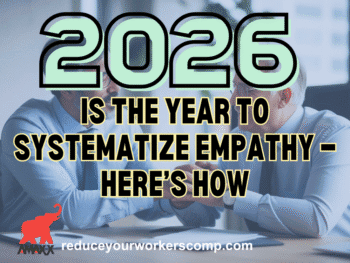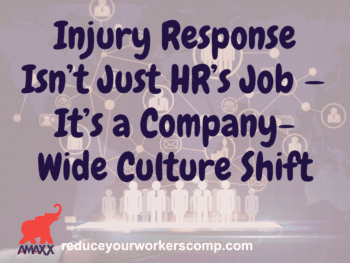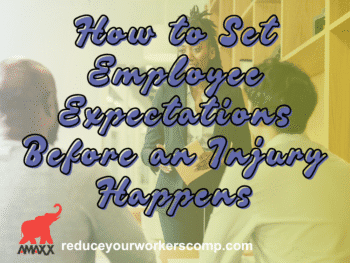Click Link to Access Free PDF Download
“9-Element Blueprint To Create Your Workers’ Comp Employee Brochure”
Intentionally Developing Rapport
The skill of being able to quickly develop rapport with injured workers over the phone will pay massive dividends over time. Hello, my name is Michael Stack and I’m the CEO of Amaxx. And we know so much of work comp management is the management of human behaviour is the management of emotions. Debbie CRI has done studies. And what is the biggest predictors of worker outcomes? Communication is definitely at the top of that list. Their feeling of trust, their feeling of safe, that they’re going to be taken care of when an injured worker or a supervisor, someone involved on the claims management team is connecting and talking with that injured worker. Those first few seconds of interaction that first 30 seconds, minute of interaction develops that feeling of comfort, that their safety, that their emotions are going to be taken care of everything. Almost everything we do is vastly impacted by our emotions.
And so if we can develop the skill of being able to develop rapport, not for manipulation standpoint, by any stretch of the imagination, but from an empathetic standpoint, from a best practices standpoint, because we want to set this claim up for success. We want to set ourselves up from a risk management standpoint for success. So we’re not trying to manipulate anyone. So if that’s your thought, your train of thought is change that thinking. That’s not what we’re trying to do at all. We’re trying to set ourselves up for success by developing the skill of being able to quickly develop report. Let’s talk about some studies of what has been done. And I think you’ve intuitively know, or we’ve heard some of these numbers. There was a study done back in the 1970s by a anthropologist called Ray bird whistle. And what he found this is study has been around for a long time.
Communication Is Key!
Communication is 7% words. So 7% the words that we’re saying it’s 38% tone, 38% tone of voice, and then 55% body language. So 55% body language. Now, if we know this research is there it’s been around for a long time, your personal experience, you’re communicating with people you can attest to this information. Yeah, that sounds about right for how much community for how communication actually works. So let’s think about some best practices, some intentionality, some points of awareness. When we’re talking on the phone with injured workers that we could just, again, set ourselves up for success, set ourselves up for success, set ourselves up for success. So a couple pieces that I want you to think about when you’re having these conversations, either in person or over the phone, but a lot of these conversations are done over the phone of how this is actually working some points of improvement.
Rapport Building Techniques
Tone Of Voice
So I want you to think about your tone of voice. So your tone of voice. Are you talking like Mickey mouse? You took him in the past. Like this year, you’re talking over the high.Is that matching? Is that that’s the way the injured worker speaks. It’s not the injured worker speaks. It’s going to really probably turn them off. So think about your tone of voice. Think about your tone of voice, of how you’re interacting.
Tempo/Pace & Volume
Think about your tempo or your pace, or you’re talking really fast or are you talking really slow? And I want you to think about the idea here of mirroring. Again, we like people who are like us. We like dealing with people that are like us. If we think that you’re the opposite and you’re a really slow talker and you’re talking with someone who’s really fast, who talks really fast, it’s not going to match up and you’re going to feel intimidated. There’s not going to be that connection. There’s not gonna be that trust. There’s not gonna be that emotional bond that they’re going to be taken care of in their time of need in their time of vulnerability. Think about your tone. Think about your tempo. Think about your pace and then think about your volume.
Now these two here over the phone, obviously, if you can’t see, the person comes down to this, connecting to this body language, connecting to how it is that you’re interacting with that individual. And again, think about the pace that, that injured worker, the person you’re speaking within the other line is we like dealing with people who are like us. We like people in general who are like us. The more that you can connect, the more that you can develop quickly build that rapport out of the gates. The more you’re going to set yourself up for success in managing that claim. Again, my name is Michael Stack and I’m the CEO of Amaxx remember your work today and worker’s compensation can have a dramatic impact on your company’s bottom line, but it will have a dramatic impact on someone’s life. So be great.
 Author Michael Stack, CEO Amaxx LLC. He is an expert in workers’ compensation cost containment systems and helps employers reduce their workers’ comp costs by 20% to 50%. He works as a consultant to large and mid-market clients, is a co-author of Your Ultimate Guide To Mastering Workers Comp Costs, a comprehensive step-by-step manual of cost containment strategies based on hands-on field experience, and is the founder & lead trainer of Amaxx Workers’ Comp Training Center, which offers the Certified Master of Workers’ Compensation national designation.
Author Michael Stack, CEO Amaxx LLC. He is an expert in workers’ compensation cost containment systems and helps employers reduce their workers’ comp costs by 20% to 50%. He works as a consultant to large and mid-market clients, is a co-author of Your Ultimate Guide To Mastering Workers Comp Costs, a comprehensive step-by-step manual of cost containment strategies based on hands-on field experience, and is the founder & lead trainer of Amaxx Workers’ Comp Training Center, which offers the Certified Master of Workers’ Compensation national designation.
Contact: mstack@reduceyourworkerscomp.com.
Workers’ Comp Roundup Blog: https://blog.reduceyourworkerscomp.com/
©2021 Amaxx LLC. All rights reserved under International Copyright Law.
Do not use this information without independent verification. All state laws vary. You should consult with your insurance broker, attorney, or qualified professional.

















